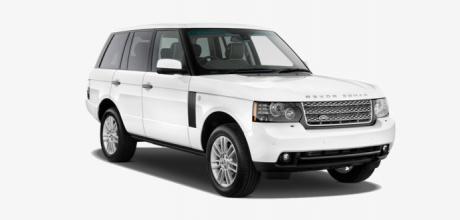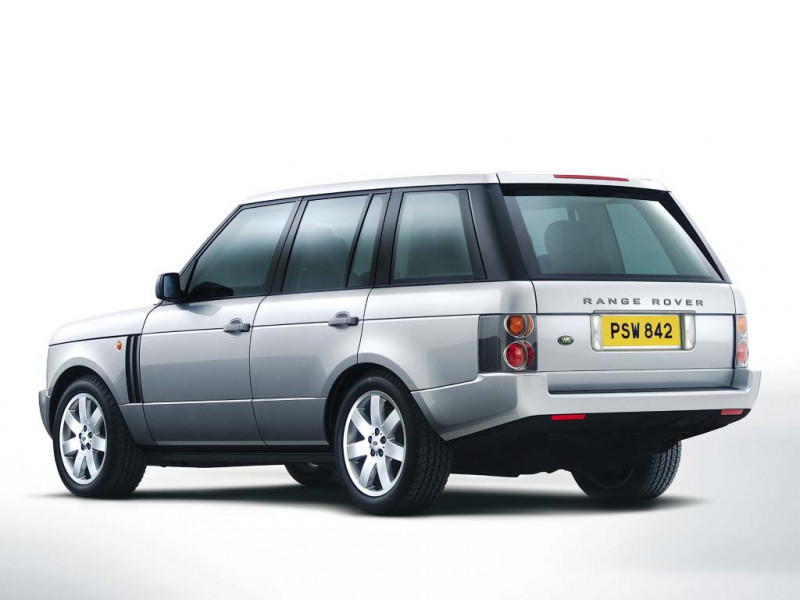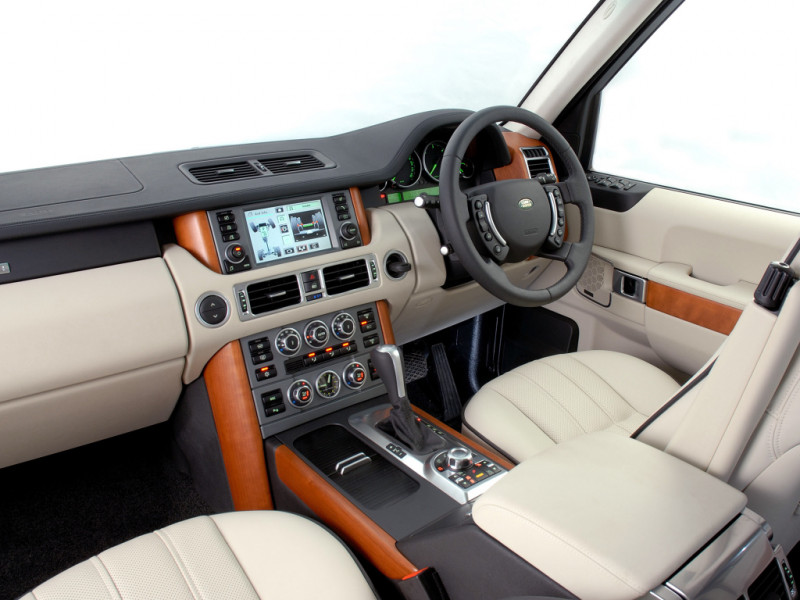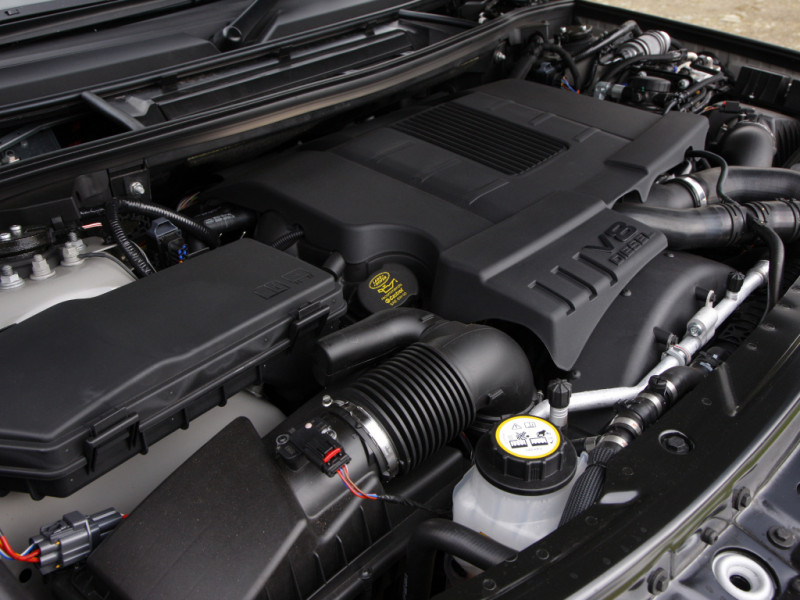Buying Guide Land Rover Range Rover L322

The third-generation Range Rover has been with us for over 20 years now and has earned its modern classic status. Here’s what you need to know. Words: CraigCheetham.
THIRD ACT
BUYING RANGE ROVER L322
All the info on the stylish third generation which combined Land Rover, BMW and Ford expertise.
On a cold and frosty evening in November 2001 at the Design Museum in London, a new chapter in luxury motoring was beginning That evening, Land Rover pulled the wraps off the third-generation Range Rover to a VIP audience and at the same time made the boldest statement yet about the brand: Land Rover was no longer about utilitarian functionality, but about upmarket motoring, the new Range Rover being the absolute epitome of that.

It was the first entirely new model to be launched under the Green Oval since it was suckered into Ford’s Premier Automotive Group alongside Jaguar, Aston Martin and Volvo, but its gestation wasn’t that straightforward as the new Range Rover had been in development since 1994. It was first and foremost, a BMW initiative and was the first vehicle on the drawing board when BMW bought Rover.
The new Range Rover was a huge break from tradition and would be the first Land-Rover to feature monocoque construction, along with advanced electronic architecture.
The initial codename for the project was L30, in line with the Freelander (L20) and Discovery 2 (L25). The L30 project was a joint one involving engineers from both Rover Group and BMW and was initially based at BMW’s Engineering Centre in Munich before transferring to Land Rover’s Solihull plant for the final stages prior to volume production.
Munich was chosen to house the team as Rover Group’s Gaydon Engineering facility was already working on the new MINI (R50) project as well as other MG Rover and Land Rover projects and did not have enough space for another large engineering team based there.

Interior style was unique at the time, intended to evoke a modern yacht.
The sale of Land Rover by BMW to Ford occurred just before the move to Solihull and the contract included a clause which continued BMW’s involvement until after the car had entered volume production.
The switch to L-XXX codenames came about after the sale to Ford with L30 being renamed L322 at the top of a model line-up of Range Rover Sport (L320) Land Rover Discovery (Discovery 3 L319), Land Rover Defender (L316) and Freelander (L314).
The third-generation Range Rover was designed to accommodate BMW’s M62 V8 engines for future models. The manual option was dropped entirely, leaving only the automatic transmission. TheBMW 7-Series E38 electronics system were being phased out during the development of the third- generation Range Rover, being replaced with the electronics from theBMW E39 5-Series. The entertainment system as well as the automotive computer bus system on pre-facelift models were almost identical to those in the BMW.
The unibody construction featured four- wheel independent air suspension, with variable ride height to offer the same axle articulation as a coil-sprung Land Rover, while the off-road ability was as peerless as any Land Rover product before or since – something that Land Rover went to great lengths to prove by entering the L322 in the new G4 Challenge, which was the spiritual successor to the legendary Camel Trophy.
Under the bonnet, there was a choice of BMW engines: the 3-litre diesel as found in the 330d E46, 530d E39 and 730d E38, and the M62B44 4.4-litre V8 seen in high end 5-Series 540i E39 and 7-Series 740i/740iL E38 models. But it was inside where the L322 really shone — the cabin was gloriously opulent and packed with tech. It was a wonderful thing with a sense of occasion like nothing else on the road at the time and was a deserved winner of multiple awards.
The biggest change in its life came in 2005, when Ford was finally able to wiggle out of the BMW engine and tech supply agreement and equip the L322 with its own powertrains. Initially, this was the 4.2-litre Jaguar V8 engine, the first pairing of Land Rover and Jaguar technology for what was later to be a fruitful future partnership. Later on, in 2007, the Range Rover got the new 3.6-litre TDV8 diesel.
Other changes included an electronic parking brake and towards the end of production, a 5-litre supercharged V8, which was both the swansong and flagship of the L322 production run.
In 2011, it was succeeded by the fourth- generation Range Rover, which was the first model fully developed by Jaguar Land Rover under Tata ownership and took the brand to even higher extremes of luxury.
WHAT TO LOOK FOR
Let’s be honest here — you’re not going to buy a cheap Range Rover L322 expecting it to be a trouble-free and inexpensive experience. Well, not unless you were bom yesterday.
This is a specialist luxury vehicle that requires specialist luxury attention and a bad example will well and truly bite you, so our first piece of advice is that if you’re not sure you can afford one, you probably can't. Repairs
are rarely cheap either. Specialist parts mean you don’t need to pay main dealer prices any more, but you’re still looking at a fair outlay in order to maintain one properly, or a ticking timebomb if you don't.
And there's a lot to love. Even now, nearly two decades after it first arrived, the L322's cabin is something else. It has an aura of bedazzling luxury accompanied by a commanding driving position that’s like that of no other car. It's a fabulous thing that makes you feel a million dollars.
It's terrific to drive, too, especially the V8. The original diesels feel a touch underpowered by comparison, but are less hassle to own and more economical so shouldn't be discounted. They make more sense as older used cars than they ever have done.
Consumable parts last reasonably well for such a large car providing you don’t drive it hard and brake discs and pads are reasonably affordable. Tyres, on the other hand, aren't so, especially if you have a V8 with 20-inch alloys where a full set of rubber will cost the same as a second-hand Vauxhall Corsa.
SUSPENSION
The air suspension is a common failure point, so look out for a saggy rear end or a car that doesn't sit level when running. It's common for the air suspension to ‘sink’ on a car that hasn’t been used for a while but providing it pops back up when started, it's not a major issue.
However, if it’s slow to rise then chances are the pressure return valve is on the way out. If it sits down on one corner, you’ve got a leaky airbag. Neither is as big a problem as you may fear, but will require a specialist fix.
BODY
Of most concern should be the overall condition of the body as unlike previous Range Rovers, the L322 is a monocoque. But despite this it has one fault in common with its predecessors: self-destructing inner wheelarches so look for rot inside the back door shuts. They can let go at an alarming rate and the rust is often hidden by the outer door leading you into a false sense of security. The earliest L322s are old cars now, so check them as carefully you might a Mk3 Escort and don't assume that their luxury gives them immunity from the traditionally biggest killer of all cars.
Look for corrosion, too, on the rear brake pipes which are extremely exposed and a pain to replace due to the location of the fuel tank.
Water ingress is a common issue: sunroof seals and windscreen surrounds can let go, allowing moisture into the cabin, while condensation can also get into both the front and rear lamp units which is rarely more than an irritation, but if left unchecked can corrode the light connections and bulb housings leading to erratic lighting problems.
Water can also collect in the bottom of the boot where the compressor for the air suspension is located, so check this area carefully and make sure there’s either a full sized or space saver spare wheel present.
BRAKES
Another electronic problem comes in the form of failing handbrake modules in post-2005 models, which is often caused by underuse and the inner mechanism of the module becoming corroded and seizing up. The good news is that the module can be accessed from inside the car and is therefore not too expensive a fix, nor is it beyond the realms of a skilled DIYer, but the part isn't cheap at over £200 for a new one.
TRANSMISSION
Transmissions are generally tough, though the diesels can suffer from a torque converter issue that if left unsorted can lead to the gearbox letting go completely. Don't be told it’s game over if the box gives up, though, as it’s actually not that big a job to replace it and if you can find a reasonably priced second-hand transmission you could be happily back on the road for less than you'd expect.
One of the most common issues that can affect the L322 is a non-functioning front differential unit. The problem isn't necessarily due to a faulty differential, as the propshaft couplings can wear, leaving the car with no drive to the front axle.
ENGINES
The V8s are generally reliable and are also chain driven, but excessive oil consumption on higher mileage examples can be a problem, not least because finding the underlying reason can be a challenge in itself.

Early BMW diesels are a known quantity but the Ford TD V8 is the driver’s choice.
Finally, erratic and nonsensical electric faults and multiple warning lights may well be enough to make you run away screaming, but in reality a full-on fruit machine show is usually down to extremely low voltages and a replacement battery (itself the size of a generator) is often enough to restore equilibrium.
VALUES
The absolute baseline for getting into L322 ownership is about £2000 and providing you're realistic that's not a bad way of doing it. You won't be buying the best example, nor will you be guaranteed a trouble-free ownership experience. But there's an inherent value to even a rough example, and a breaker will most likely give you £1500 or more for a complete car. There's logic behind Range Rover bangrnomics… up to a point.
But if you want a good car that's going to last you, double that budget and you'll be into the realms of well-maintained and tidy pre- facelift examples that have quite a bit of life left in them, or the post-2005 examples that are considered to be better made, though our preference against this backdrop would be for a well-maintained older car. Because the L322 remained on sale until late 2011, the newest examples still command five figures and are still depreciating, while special editions such as the Westminster and 40h Anniversary are already bordering on collectable status. In my opinion, a low mileage, good condition and well-specced early VS L322 could well turn out to be a sound future investment as well.
Despite the luxury, the L322 remained one of the world’s most capable off-roaders.
WHICH MODEL
If you want to truly absorb yourself in the L322 experience, then V8 is the way to go. Eager, responsive and as smooth as Roger Moore, the power delivery is part of the sensory experience of driving what was, in 2002, probably the best car in the world. Yet it isn’t just the luxury, performance and refinement that shine through. The L322 is also brilliant off-road and 100% true to its Land Rover DNA, while at the same time being quite a useful workhorse if that’s what you need it to be with 3.5-tonne towing capability and a huge boot. Indeed, we know of several L322 owners who have a ‘normal’ car for everyday use and an L322 for when they need it, as a caravan tow car and tip run special — a far cry from the ‘Tea at Claridge’s” image it had when new, but affirmation that the Range Rover does everything that green oval proclaims it can do.
If you want an L322 that’s not going to cost you a few quid, buy a Discovery Td5 instead. It might not have the same sense of occasion, but it also won’t bankrupt you. If you’re still reading, then the cheapest way through the Range Rover door is in the form of the 3.0 Td6, which used BMW’s straight-six oil burner. It was a decent and refined engine in the 5-Series, but met its limit in the L322 and needs to be worked hard, meaning it’s not at the peak of its efficiency. 24-25mpg is about as good as it gets. The diesels are generally cheaper to insure, though, and are fairly reliable. The V8 models love a drink. Land Rover liked you to believe that 23mpg was about right, but in real-world use you’re often lucky to get more than 18mpe unless cruising. so be prepared for heady fuel costs.
INSURANCE COSTS
Quotation supplied by Lancaster Insurance
1 2004 Range Rover 2.9 diesel, value £4000 £209.26 or £227.26 with Agreed Value
2 Based on 45-year old, with a second vehicle. It’s garaged, covers 3000 miles a year and lives in an SP2 postcode. They have no claims or convictions, are a club member, and are employed as a marketing manager.
Disclaimer: Policy benefi ts, features and discounts offered may vary between insurance schemes or cover selected and are subject to underwriting criteria.
3 Subject to underwriting criteria.
www.lancasterinsurance.co.uk 01480 809176
EV SAYS...
Andrew Evanson
Senior Operations Manager at Lancaster Insurance Services, says: “Despite being a much more complex and modern car, the third-generation Range Rover can actually be an easier ownership proposition than the P38a generation, especially for owners who don't fancy DIY tinkering.
Buy a good one and it should prove to be an affordable allpurpose tool which will last you a long time.”
OR MAYBE..?
Paul Wager, Group Editor – Discovery 2
The L322 Range Rover may be a long way from the original Discovery, based as it was on the chassis of the first-generation Range Rover but the BMW-financed evolution into the Discovery 2 was a dramatic update and if you want the seven seats and a more modern ownership experience but don't fancy the well-publicised reliability issues of the Discovery 3, then it makes a lot of sense. In TDS-engined form, it's both economical and respectably brisk, even if the TDV8 Range Rover will outdrag it every time. Oh and the really late-model Disco 2's even had a front-end facelift with lights to mimic the Range Rover.
Dave Youngs, Lancaster Insurance – Porsche Cayenne
Yes, it may be hard to believe but the unlikely Porsche SUV will celebrate its 20th birthday next year. Purists sneered when the Cayenne – based on the VW Touareg – was unveiled, but Porsche badly needed a model to keep up with the competition – think X5 and M-Class — and this was just the ticket. Indeed, sales were strong and it seemed buyers didn't care if you could see VW part numbers behind the scenes, to the point where the Cayenne is credited — just like the Boxster — with saving Porsche as a brand. Today the early cars are available for as little as £2000 but we'd suggest spending rather more to get an example you can be proud of and enjoy: budget on £5000 and avoid the many Cat D examples.

